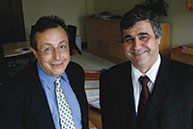Planning for uncertainty: the math of mining
Planning for uncertainty: the math of mining McGill University
User Tools (skip):
Planning for uncertainty: the math of mining
Mining is one of the most uncertain industries around. Not only is it impossible to know the volume of a metal or mineral in a particular ore body, it's also impossible to predict the market value of the product once you've gone to all the trouble and expense to extract it.

Roussos Dimitrakopoulos and Dean Christophe Pierre are proud to launch the Stochastic Mine Planning lab.
Owen Egan
Most mining companies deal with this double whammy of uncertainty by using mathematical models that make no allowances for guesswork, explained Roussos Dimitrakopoulos from his office next to the Stochastic Mine Planning Laboratory. The professor of mining engineering and Canada Research Chair in Sustainable Mineral Resource Development and Optimization Under Uncertainty is a world leader in stochastics, the science of uncertainty.
"I like the comparison to weather prediction that a mining engineer from [mining company] Rio Tinto once used," said Dimitrakopoulos, "Imagine what our lives would be like if the prediction of the weather one month from now was determined by looking out the window today for one second. That's what it's like in mining."
Dimitrakopoulos and his group of researchers and collaborators from industry work to incorporate uncertainty into the mathematical models used by mining companies to plan their operations. "We have been able to establish the interaction between uncertainty [in the ore body and in the market] and in discounting, or the devaluing of money over time."
And the results are promising: In studies he conducted while working with BHP Billiton, the Australia-based mining giant, Dimitrakopoulos' approach resulted in a five- to 20-percent increase in the value of mining operations compared to conventional methods. His success prompted BHP Billiton to set up an international research lab funded, in part, by mining companies, to further his stochastic modelling and enhance McGill's Department of Mining Engineering.
BHP Billiton put up $800,000 to be used over five years, matched by a Collaborative Research and Development grant from the Natural Sciences and Engineering Research Council of Canada, for a total of $1.6 million.
Dimitrakopoulos officially launches the Stochastic Mine Planning lab on September 8, and the guests will include representatives of the lab's eight partners: BHP Billiton, the London-based Rio Tinto, Canadian companies INCO and Barrick Gold, the American Newmont Gold, the South African AngloGold Ashanti and De Beers companies and the Brazilian CVRD.
What sets Dimitrakopoulos' lab apart from other engineering labs at McGill is that the companies involved have agreed to give $50,000 per annum for five years as well as provide the lab with problems and feedback on the proposed solutions, a relationship that Dimitrakopoulos values.
"I can't be a good engineer or scientist without working with the people in the field," said Dimitrakopoulos. "This lab isn't only about academic papers."
One of the partner companies, De Beers Canada, part of the international diamond-mining operation, has worked with Dimitrakopoulos. Malcolm Thurston, vice-president, Mineral Resource Management, De Beers Canada, said that, "One of the major problems we face is to optimize exploitation of the ore body. This implies an understanding of what run-of-mine material must be removed in space and time to get the best return possible for the project. This must be balanced against the risk imposed with respect to people, mining equipment and the natural resource itself. The laboratory at McGill is making a contribution in this area and early results have been implemented with success at a specific De Beers operation in South Africa."
Thurston also sees the lab as a place for "shaping and training the leaders of tomorrow in this field." At the moment, those leaders of tomorrow now working in the lab include three research associates, seven graduate students and two graduate students shared with other departments.
Dean of the Faculty of Engineering Christophe Pierre is particularly pleased by the multidisciplinary and international aspects of the lab. He noted that other McGill professors collaborating with the lab come from the fields of electrical and computer engineering as well as from math and management. External collaborators include a specialist in production scheduling from the Colorado School of Mines, a petroleum engineer from Stanford University and a researcher from the Paris School of Mines.
"This lab fits well with the priorities of the faculty, which include strengthening research programs with industry, being international in scope and providing research opportunities for students," said Pierre.
"It's rare for a university lab to have such formally organized partnerships with industry," he continued. "This is a model we would like to see become more prevalent, but that only happens when you've earned the respect of an entire industry. The very existence of this lab is a testament to Roussos being a global leader in this field."

